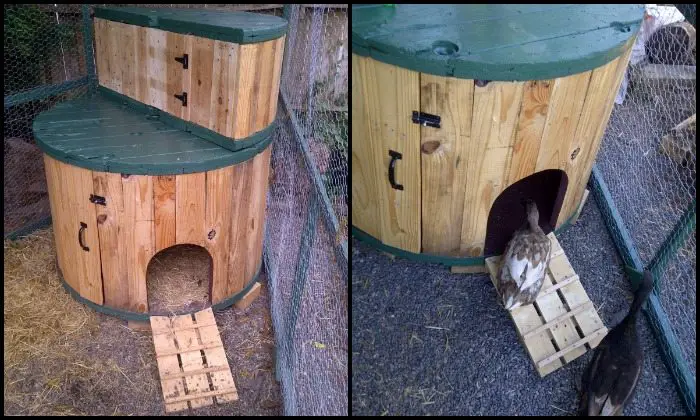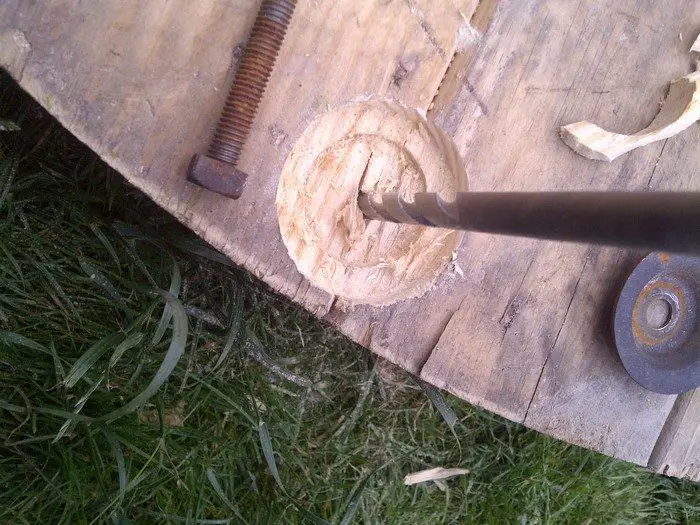
After the recess was roughly shaped to the contours of the washer, I drilled the hole for the bolt itself. Note: It’s important to do this after you use the hole saw bits, because a hole saw needs wood to “bite,” onto your cable spool duck house. If you were to drill the bolt hole first, the saw would slip around dangerously.
I repeated this for all six bolts on both sides of the spool, for a total of twelve new holes.

Loosely assemble
At this point, I replaced a couple of slats and loosely fit all of the bolts.
What I discovered was:
First, my measurements for my cable spool duck house weren’t perfect, so some of the bolts were a tiny bit misaligned. Not a big deal – that’s why they invented hammers.
Second, the bolts were, in fact, long enough to work even when not sitting in slots. See, in moving the slats to the outside, I was increasing the overall height by about an inch, because I didn’t route out slots for them in their new positions out at the edge. Luckily there’s enough play in the threading and length of the bolts that I didn’t need to route a slot to make it all fit, but that might be worth doing if you have the tools and the inclination.
Careful not to smash my toes or fingers or skull or fine china or small pets, and happy that I wouldn’t have to go back and deepen all of the bolt hole recesses, I dropped the cumbersome assembly down onto its “bottom” for the next steps.

Add the boards
I placed the original “load-bearing” boards in groups near the big bolts. for my cable spool duck house When tightened, the bolts “pinch” the boards for a nice strong joint. A few screws keep the boards in place.
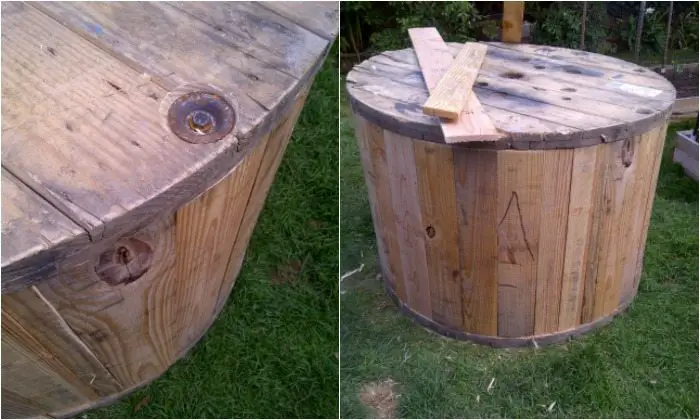
Various (mostly 1″x4″) slats harvested from palettes filled in the remaining gaps.

The door
the door for my cable spool duck house had to be big enough to comfortably reach inside the house for cleaning, egg-stealing, and such. And I was so impressed with the sturdiness, I ended up removing a bolt and making the door as wide as the span between the two adjacent bolts.
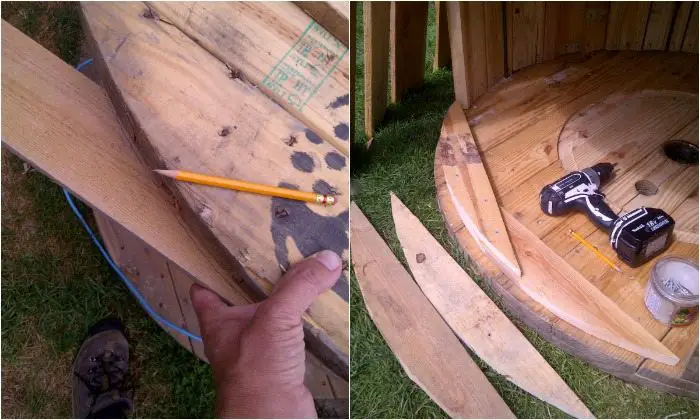
I started by tracing the arc onto some boards…
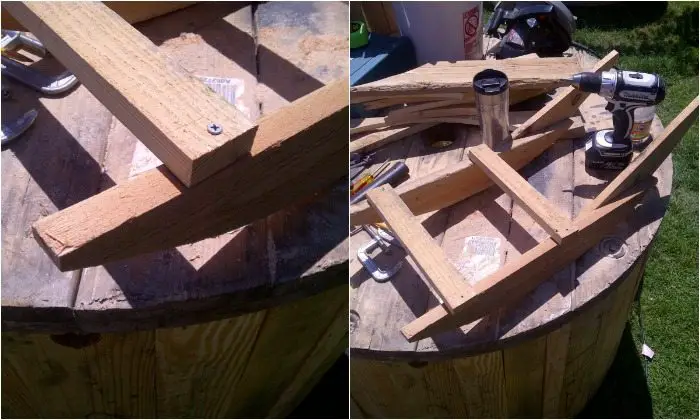
and sticking them together to make an assembly reminiscent of a rocking horse that rocked rather well and made me kind of want to make a rocking horse. But I didn’t.

I temporarily hung the rocking-horse-looking frame into place, accidentally putting the hinge on the right side when I meant to make the door open the other way.
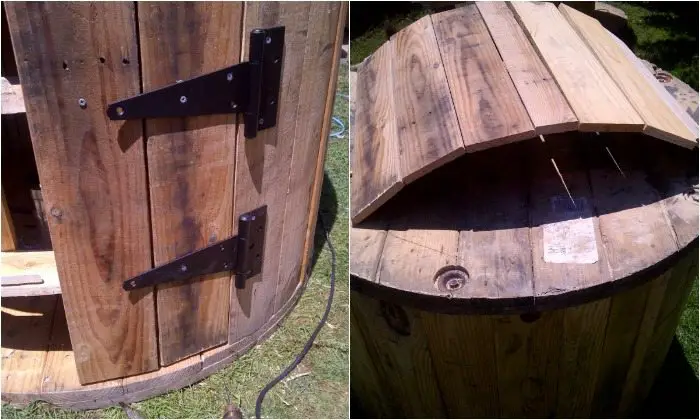
I took it off and added more slats, so that it started to look like a medieval shield of some kind, and made me kind of want to make a medieval shield. But I didn’t.
In retrospect, I should not have maintained a nice arc; I should have flattened the arc where each slat touches it. That would have made attaching them much easier. You really should do that if you make one of these.
I hung the door and added a handle and a latch.
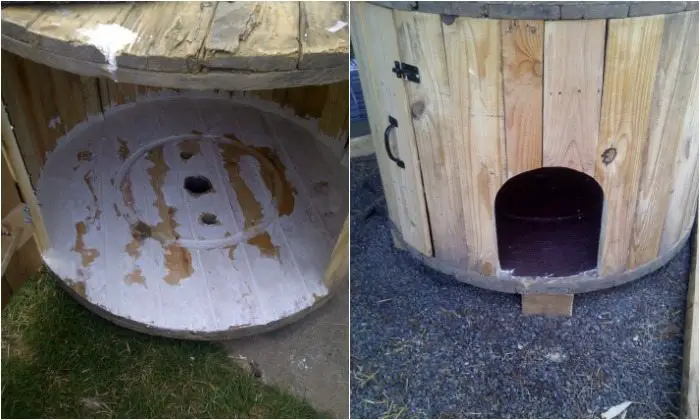
Fill and paint
The sides got a quick sanding and an even quicker coat of varnish. I filled the big internal gaps, painted the inside brown and the top green, and carved out a duck-sized entrance.
Since this house will be placed in a large aviary-like enclosure safe from raccoons and other predatory beasties, and since ducks don’t just sleep all night like chickens, the duck entrance didn’t need a door. So it didn’t get one.
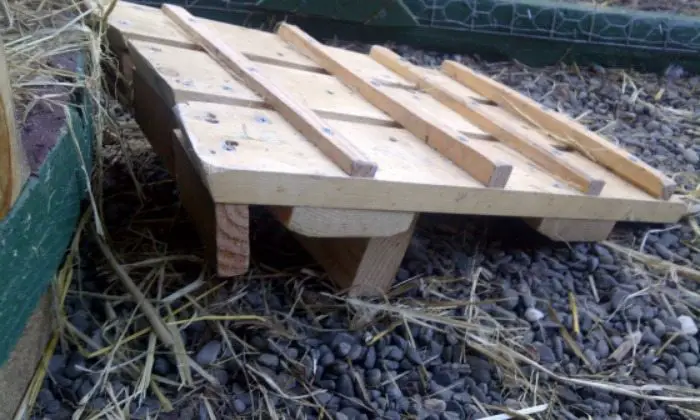
It did get a ramp, though – made from palette wood and just sort of parked up against the duck door.
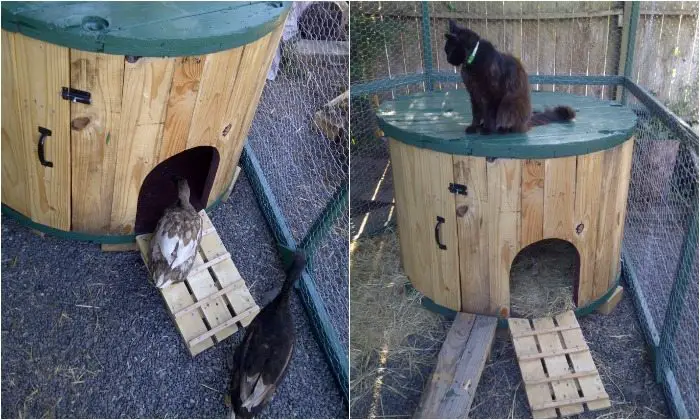
And that’s it! The ducks love it, and so does the occasional cat.
Thanks to mcraghead for this great project!
Contents
Weatherproofing Techniques
Weatherproofing your cable spool duck house is crucial to ensure it remains a safe, dry, and comfortable habitat for your ducks throughout the year. Heavy rain and snow blankets will slowly degrade your duck’s home over time if it has no protection from the elements. By implementing effective weatherproofing techniques, you can protect your feathered friends and extend the lifespan of the duck house.
This section will guide you through various strategies to shield your cable spool duck house against the elements.
Seal and Insulate
Start by sealing any gaps or cracks in the cable spool duck house with a waterproof filler or sealant. This prevents water from seeping in and helps maintain a stable internal temperature. Insulating the walls and floor of the duck house can also provide extra protection against cold weather. Materials like straw or foam panels can be used for insulation, ensuring that the ducks remain warm during winter months.
Waterproofing the Exterior
Apply a waterproof paint or varnish to the exterior surfaces of the cable spool duck house. This creates a moisture barrier that repels water and prevents the wood from rotting.
The roof and base should have proper protection since these are always exposed to rains, snow, and UV rays. A sloped roof design ensures water runs off easily, reducing the risk of leaks.
Ventilation for Humidity Control
Proper ventilation is essential to prevent condensation buildup inside the cable spool duck house, which can lead to mold and mildew growth. Install vents or small windows that can be opened or closed depending on the weather. This allows for air circulation while keeping the interior dry. Ensure that the ventilation openings are covered with wire mesh to keep predators out.
Elevated Design
Raising the cable spool duck house off the ground on sturdy legs or a platform can prevent flooding and minimize moisture infiltration. This elevation also protects the base of the duck house from direct contact with wet soil, further reducing the risk of wood decay. Ensure that the structure is stable and secure to withstand strong winds.
Weather-Resistant Entrance
The entrance to the cable spool duck house should be designed to prevent rainwater from entering. Add a small awning or overhang above the door to shield the entrance from direct rainfall. Additionally, a raised threshold can help prevent water from flowing inside. If your area is prone to harsh weather, installing a door flap can offer extra protection while allowing the ducks easy access.
These weatherproofing techniques let you create a durable, resilient cable spool duck house against the elements. Not only will this ensure the comfort and safety of your ducks, but it will also preserve the integrity of your cable spool duck house for years to come.
Conclusion
Building a cable spool duck house offers an innovative and eco-friendly solution for duck owners seeking a comfortable and secure habitat for their feathered friends. Through creative recycling of materials and thoughtful design, this project provides a unique shelter for ducks and contributes to sustainability efforts. The process fosters a sense of accomplishment and a deeper connection with nature, highlighting the joy and responsibility of caring for animals in our backyards.
We offer more ways to make your duck’s life comfortable. Read our guide on building a duck deck!

